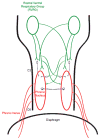Treatments to restore respiratory function after spinal cord injury and their implications for regeneration, plasticity and adaptation
- PMID: 22200541
- PMCID: PMC3334458
- DOI: 10.1016/j.expneurol.2011.12.018
Treatments to restore respiratory function after spinal cord injury and their implications for regeneration, plasticity and adaptation
Abstract
Spinal cord injury (SCI) often leads to impaired breathing. In most cases, such severe respiratory complications lead to morbidity and death. However, in the last few years there has been extensive work examining ways to restore this vital function after experimental spinal cord injury. In addition to finding strategies to rescue breathing activity, many of these experiments have also yielded a great deal of information about the innate plasticity and capacity for adaptation in the respiratory system and its associated circuitry in the spinal cord. This review article will highlight experimental SCI resulting in compromised breathing, the various methods of restoring function after such injury, and some recent findings from our own laboratory. Additionally, it will discuss findings about motor and CNS respiratory plasticity and adaptation with potential clinical and translational implications.
Copyright © 2011 Elsevier Inc. All rights reserved.
Figures

Similar articles
-
Supraspinal respiratory plasticity following acute cervical spinal cord injury.Exp Neurol. 2017 Jul;293:181-189. doi: 10.1016/j.expneurol.2017.04.003. Epub 2017 Apr 19. Exp Neurol. 2017. PMID: 28433644 Free PMC article.
-
Functional regeneration of respiratory pathways after spinal cord injury.Nature. 2011 Jul 13;475(7355):196-200. doi: 10.1038/nature10199. Nature. 2011. PMID: 21753849 Free PMC article.
-
Light-induced rescue of breathing after spinal cord injury.J Neurosci. 2008 Nov 12;28(46):11862-70. doi: 10.1523/JNEUROSCI.3378-08.2008. J Neurosci. 2008. PMID: 19005051 Free PMC article.
-
Effect of spinal cord injury on the neural regulation of respiratory function.Exp Neurol. 2008 Feb;209(2):399-406. doi: 10.1016/j.expneurol.2007.05.015. Epub 2007 May 31. Exp Neurol. 2008. PMID: 17603041 Review.
-
Enhancing neural activity to drive respiratory plasticity following cervical spinal cord injury.Exp Neurol. 2017 Jan;287(Pt 2):276-287. doi: 10.1016/j.expneurol.2016.08.018. Epub 2016 Aug 28. Exp Neurol. 2017. PMID: 27582085 Free PMC article. Review.
Cited by
-
Laryngeal and swallow dysregulation following acute cervical spinal cord injury.J Neurophysiol. 2022 Aug 1;128(2):405-417. doi: 10.1152/jn.00469.2021. Epub 2022 Jul 13. J Neurophysiol. 2022. PMID: 35830612 Free PMC article.
-
Cortical reorganization after spinal cord injury: always for good?Neuroscience. 2014 Dec 26;283:78-94. doi: 10.1016/j.neuroscience.2014.06.056. Epub 2014 Jul 2. Neuroscience. 2014. PMID: 24997269 Free PMC article. Review.
-
Is Innervation of the Neuromuscular Junction at the Diaphragm Modulated by sGC/cGMP Signaling?Front Physiol. 2020 Jun 23;11:700. doi: 10.3389/fphys.2020.00700. eCollection 2020. Front Physiol. 2020. PMID: 32655417 Free PMC article.
-
Spinal cord injury: global burden from 1990 to 2019 and projections up to 2030 using Bayesian age-period-cohort analysis.Front Neurol. 2023 Dec 5;14:1304153. doi: 10.3389/fneur.2023.1304153. eCollection 2023. Front Neurol. 2023. PMID: 38116113 Free PMC article. Review.
-
Degeneration of phrenic motor neurons induces long-term diaphragm deficits following mid-cervical spinal contusion in mice.J Neurotrauma. 2012 Dec 10;29(18):2748-60. doi: 10.1089/neu.2012.2467. Epub 2012 Nov 23. J Neurotrauma. 2012. PMID: 23176637 Free PMC article.
References
-
- Alilain WJ, Horn KP, Dick TE, Silver J. 2006 Neuroscience Meeting Planner. Atlanta, GA: Society for Neuroscience; 2006. Chondroitinase ABC-induced reduction of chondroitin sulfate proteoglycans and the perineuronal net following C2 hemisection. Program No. 720.7. Online.
-
- Alilain WJ, Horn KP, Dick TE, Silver J. 2007 Neuroscience Meeting Planner. San Diego, CA: Society for Neuroscience; 2007. Chondroitinase ABC treatment following C2 hemisection results in dramatically enhanced ipsilateral hemi-diaphragmatic recovery. Program No. 137.4. Online.
Publication types
MeSH terms
Grants and funding
LinkOut - more resources
Full Text Sources
Medical

